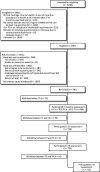Cohort profile: demographic and clinical characteristics of the MILESTONE longitudinal cohort of young people approaching the upper age limit of their child mental health care service in Europe
- PMID: 34916319
- PMCID: PMC8679118
- DOI: 10.1136/bmjopen-2021-053373
Cohort profile: demographic and clinical characteristics of the MILESTONE longitudinal cohort of young people approaching the upper age limit of their child mental health care service in Europe
Abstract
Purpose: The presence of distinct child and adolescent mental health services (CAMHS) and adult mental health services (AMHS) impacts continuity of mental health treatment for young people. However, we do not know the extent of discontinuity of care in Europe nor the effects of discontinuity on the mental health of young people. Current research is limited, as the majority of existing studies are retrospective, based on small samples or used non-standardised information from medical records. The MILESTONE prospective cohort study aims to examine associations between service use, mental health and other outcomes over 24 months, using information from self, parent and clinician reports.
Participants: Seven hundred sixty-three young people from 39 CAMHS in 8 European countries, their parents and CAMHS clinicians who completed interviews and online questionnaires and were followed up for 2 years after reaching the upper age limit of the CAMHS they receive treatment at.
Findings to date: This cohort profile describes the baseline characteristics of the MILESTONE cohort. The mental health of young people reaching the upper age limit of their CAMHS varied greatly in type and severity: 32.8% of young people reported clinical levels of self-reported problems and 18.6% were rated to be 'markedly ill', 'severely ill' or 'among the most extremely ill' by their clinician. Fifty-seven per cent of young people reported psychotropic medication use in the previous half year.
Future plans: Analysis of longitudinal data from the MILESTONE cohort will be used to assess relationships between the demographic and clinical characteristics of young people reaching the upper age limit of their CAMHS and the type of care the young person uses over the next 2 years, such as whether the young person transitions to AMHS. At 2 years follow-up, the mental health outcomes of young people following different care pathways will be compared.
Trial registration number: NCT03013595.
Keywords: adult psychiatry; child & adolescent psychiatry; international health services.
© Author(s) (or their employer(s)) 2021. Re-use permitted under CC BY-NC. No commercial re-use. See rights and permissions. Published by BMJ.
Conflict of interest statement
Competing interests: SPS is part-funded by the National Institute for Health Research (NIHR) Collaboration for Leadership in Applied Health Research and Care West Midlands (NIHR CLAHRC WM), now recommissioned as NIHR Applied Research Collaboration West Midlands. The views expressed in this publication are those of the author(s) and not necessarily those of the NIHR or the Department of Health and Social Care. PS is the co-inventor of the HealthTrackerTM and is the Chief Executive Officer and shareholder in HealthTracker Ltd. FF is a Chief Technical Officer and AK is the Chief Finance Officer employed by HealthTracker Ltd respectively. FCV publishes the Dutch translations of ASEBA, from which he receives remuneration. AM was a speaker and advisor for Neurim, Shire, Infectopharm and Lilly (all not related to transition research).
Figures



References
-
- Perera RH, Rogers SL, Edwards S, et al. . Determinants of transition from child and adolescent to adult mental health services: a Western Australian pilot study. Aust Psychol 2017;52:184–90.10.1111/ap.12192 - DOI
-
- Leavey G, McGrellis S, Forbes T, et al. . Improving mental health pathways and care for adolescents in transition to adult services (impact): a retrospective case note review of social and clinical determinants of transition. Soc Psychiatry Psychiatr Epidemiol 2019;54:955–63.10.1007/s00127-019-01684-z - DOI - PubMed
Publication types
MeSH terms
Associated data
LinkOut - more resources
Full Text Sources
Medical
